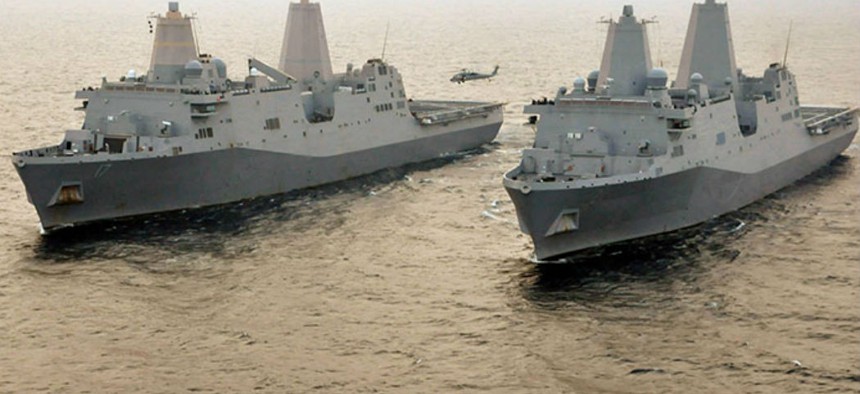Navy Extends "Netted" Sensor Ship Defense Technology
By extending its Cooperative Engagement Capability contract with Raytheon, the Navy will sustain and increase its ability to defend surface ships from distances beyond the horizon. Networked or "netted" sensors can enable ships to track and destroy approaching enemy fire from drones, anti-ship missiles or other threats.
The Navy is accelerating efforts to better network sensors to weapons systems so that missiles, drones and ship-based weapons systems can locate and destroy approaching targets at distances “beyond-the-horizon.”
Raytheon will further develop sensor, radar and “detect-control-engage” technology through a second extension of its Cooperative Engagement Capability (CEC) contract.
Raytheon Integrated Defense Systems was awarded a $19 million CEC contract for a sensor netting system engineered to improve sensor integration and anti-warfare capability, Pentagon and Raytheon statements explained.
“CEC is a sensor netting system that significantly improves battle force anti-air warfare capability by extracting and distributing sensor-derived information such that the superset of this data is available to all participating CEC units,” a Raytheon statement said.
CEC is an integral aspect of key emerging ship-defense technologies aimed at “netting” sensors and radar technologies in order to better identify and destroy approaching threats such as anti-ship missiles, drones and enemy aircraft.
Navy leaders and weapons developers speak often about the tremendous combat value of networking airborne, missile and ship sensors as a way to better identify over-the-horizon threats.
For example, Navy destroyers, or DDG 51s, have already deployed with a new offensive and defensive technology called Naval Integrated Fire Control – Counter Air, or NIFC-CA. This system, deployed for the first time last year, uses an airborne sensor and data links to relay information about incoming enemy fire.
NIFC-CA technology, which has used both an F-35 and E2-D Hawkeye as an airborne sensor to track and relay threat information, connects to a ship-based fire-control system able to launch an SM-6 to intercept store threats at further distances the ship defenses were previously able to do. NIFC-CA has previously been utilized with an E2D Hawkeye surveillance plane, but the Navy recently conducted a successful test using an F-35 as the airborne relay sensor.
With an active seeker, an SM-6 is able to send an electromagnetic signal or “ping” forward from the missile itself; by not needing a ship-based illuminator, the missile can use its own integrated “active” seeker technology to better pursue moving or fast-changing targets while in flight. Analyzing electromagnetic energy traveling at the speed of light, ship-based radar, fire-control and computer systems assess the return signal to determine the shape, size, speed and distance of an approaching threat.
As part of what the Navy calls Baseline 9 Aegis radar technology, almost every destroyer in the fleet will be integrated with NIFC-CA. In addition, many analysts and weapons observers have made the point that NIFC-CA could also be quite useful for offensive attack operations.
Aegis can, of course, assist ships with longer-range ballistic missile defense technology using weapons such as an SM-3. For nearer in threats, however, Aegis radar can help integrate with an SM-6 to better protect surface ships from attack.
Connecting sensors together with CEC, quite naturally, is key to this process – thus underscoring the continued Navy emphasis upon emerging computer processing speed with this second contract.
CEC connects with the Raytheon-developed Ship Self Defense System, which is used on most classes of Navy ships including amphibious transport dock warships such as the USS San Antonio (LPD 17) and USS New York (LPD 21)), Raytheon information explains.
“A Navy strike group has a variety of sensors to identify threats, including surface radars, sonar and airborne sensors, along with weapons systems that can engage a threat at various distances. CEC is the integration layer that moves data from the sensors to the appropriate weapon systems, creating what military strategists call an end-to-end, detect-control-engage capability,” a Raytheon statement explained.
The real-time, composite network picture provided by CEC is also more resistant to electronic jamming, Raytheon developers added.
As a sensor “netting” technology, CEC is also quite consistent with the Navy’s current “distributed lethality” strategy – an effort to better arm the surface fleet with offensive and defensive weapons technologies. The “distributed” aspect is designed to allow for more expansive dis-aggregated operations so surface ship sensors, radars, radios and communication system can better network over larger distances. Furthermore, greater distribution of the surface force is designed to prevent groups of ships from being targeted by the enemy.
CEC also works with newer sensor platforms like the Joint Land Attack Cruise Missile Defense Elevated Netted Sensor System (JLENS), which deploys sensors carried aloft on an aerostat. Vagle's team is in the process of integrating the Navy's next generation Air and Missile Defense Radar (AMDR) and the multi-function radar on the new DDG-1000 Zumwalt-class destroyers, Raytheon developers explained.
Work on the contract will be performed in St. Petersburg, Fla., and is expected to be completed in September 2017. The contract will include design elements as well as engineering.




